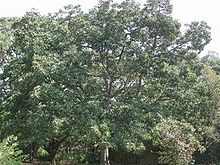| Terminalia bellirica | |
|---|---|

| |
| Scientific classification | |
| Kingdom: | Plantae |
| Clade: | Tracheophytes |
| Clade: | Angiosperms |
| Clade: | Eudicots |
| Clade: | Rosids |
| Order: | Myrtales |
| Family: | Combretaceae |
| Genus: | Terminalia |
| Species: | T. bellirica
|
| Binomial name | |
| Terminalia bellirica | |
Terminalia bellirica, known as baheda, bahera, behada, beleric or bastard myrobalan (Arabic: beliledj بليلج,[2] borrowed from Middle Persian Balilag), Persian بلیله (Balileh),[3] Sanskrit: Vibhītaka बिभीतक,[4] Aksha अक्ष[5]) is a large deciduous tree in the Combretaceae family. It is common on the plains and lower hills in South and Southeast Asia, where it is also grown as an avenue tree. The basionym is Myrobalanus bellirica Gaertn. (Fruct. Sem. Pl. 2: 90, t. 97. 1791). William Roxburgh transferred M. bellirica to Terminalia as "T. bellerica (Gaertn.) Roxb.". This spelling error is now widely used, causing confusion. The correct name is Terminalia bellirica (Gaertn.) Roxb.[6]
- ^ Plummer, J. (2021). "Terminalia bellirica". IUCN Red List of Threatened Species. 2021: e.T61989645A61989649. Retrieved 6 February 2023.
- ^ Raymond, Arveiller (1999). Addenda au FEW XIX (Orientalia). Max Niemeyer Verlag Tübingen. ISBN 978-3-11-092771-9.
- ^ Dehkhoda, Ali Akbar, and Muḥammad Muʻīn. 1946. Loghat-nama (Dictionnaire encyclopédique). Téhéran: Université de Téhéran, Faculté des lettres, Institut Loghat-Nama: بلیله
- ^ Cologne Digital Sanskrit Dictionaries - Monier Williams Sanskrit-English Dictionary page 978 [1]
- ^ Cologne Digital Sanskrit Dictionaries - Monier Williams Sanskrit-English Dictionary page 3 [2]
- ^ IPNI database
